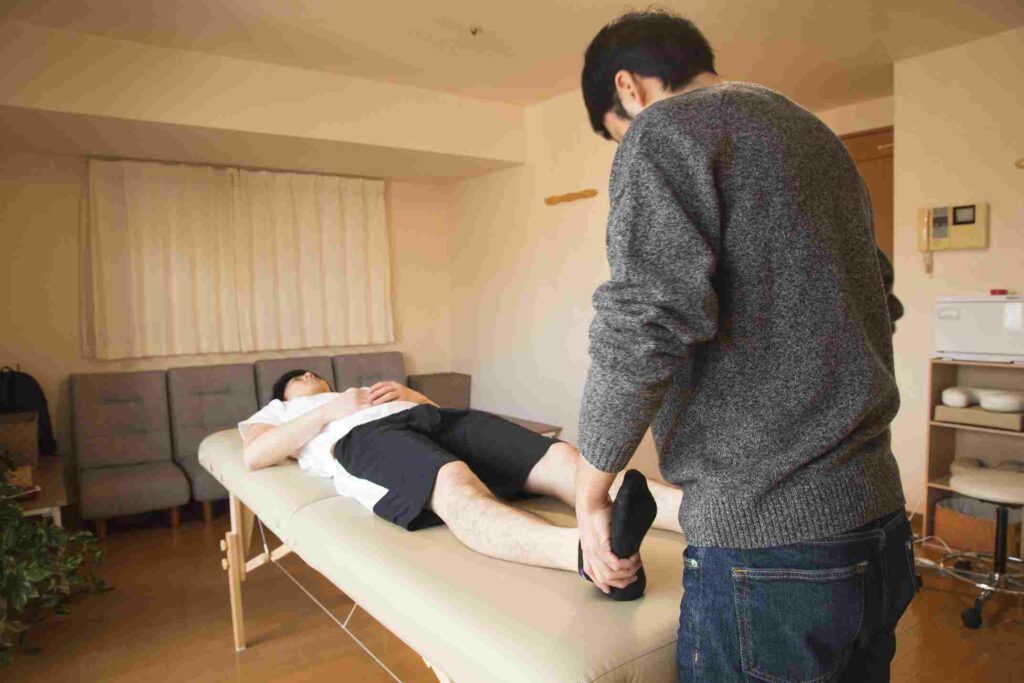If you are suffering from piriformis syndrome, you know just how painful and frustrating it can be. This condition can make it difficult to walk, sit, or even sleep. Thankfully, there is help! In this guide, we will discuss physical therapy for piriformis syndrome and the benefits it can provide. We will also cover some of the most common exercises used in physical therapy to treat this condition.
Contents
What Is Piriformis Syndrome?

Piriformis syndrome is a condition that affects the piriformis muscle. This muscle is located in the buttocks, and its main function is to rotate the hip outward. The problem with piriformis syndrome is that the muscle can become irritated or tight, and this can lead to pain and discomfort in the buttocks area.
There are several different treatment options for piriformis syndrome, but one of the most effective is physical therapy. Physical therapy can help to stretch and strengthen the muscles around the piriformis, which can ultimately lead to less pain and discomfort.
Does physical therapy help with piriformis syndrome?
Yes, physical therapy can help with piriformis syndrome. A physical therapist can teach you stretches and exercises to help relieve your pain and improve your range of motion. They may also use modalities such as heat or cold therapy to help reduce inflammation. If your piriformis syndrome is caused by a muscle imbalance, your physical therapist can create a custom strengthening program to help correct the imbalance and prevent further injury.
What Types Of Physical Therapy Is Used For Piriformis Syndrome?

There are a few key components that should be included in a physical therapy program for piriformis syndrome.
There are various physical therapy is used for piriformis syndrome. They are as follows:
Stretching Exercises
Static stretches are held for some time, usually 15 to 30 seconds, without moving in and out of the stretch. An example of a static stretch for the piriformis muscle is the supine piriformis stretch. For example, the following are dynamic stretches for the piriformis muscle:
Passive stretches are where someone else moves your leg into the stretch position and you relax into the stretch. An example of a passive stretch for the piriformis muscle is the side-lying hip abduction with external rotation.
Active stretches are where you move your leg into the stretch position and hold it there without assistance. An example of an active stretch for the piriformis muscle is the standing hip hike.
Functional exercises are exercises that simulate everyday movements. The following are examples of functional exercises for the piriformis muscle:
The following are examples of strengthening exercises for the piriformis muscle:
- Clamshell Exercise
- Side-Lying Hip Abduction
- Hip Hike
- Lunge with Rotation
Ice/Heat Therapy
Applying ice or heat to an injured or sore area is a common method of pain relief. Ice is most often used during the acute phase, or first 72 hours, of an injury to reduce swelling. Heat is most often used after the acute phase to help relieve muscle stiffness.
Massage Therapy
Various types of massage therapy can be used to treat piriformis syndrome. They are as follows:
Swedish Massage: This is the most common type of massage. It uses long, smooth strokes and light to medium pressure.
Deep Tissue Massage: This type of massage uses slower, more forceful strokes to target the deeper layers of muscle and connective tissue. This type of massage is often used to treat chronic pain and muscle tension.
Trigger Point Massage: This type of massage focuses on specific areas of muscle tension. The therapist applies pressure to the trigger point, or knots, in the muscle to release the tension. For example, the following are trigger points in the piriformis muscle.
Aquatic Therapy
Aquatic therapy, or water therapy, is a type of physical therapy that is done in a pool. The water helps to support your body weight and decreases the amount of stress on your joints. Aquatic therapy can be helpful for people with piriformis syndrome because it allows you to perform exercises that may be difficult on land. It can also help to reduce pain and swelling.
The following are examples of exercises that can be done in an aquatic therapy program for piriformis syndrome:
- Water Walking: This is a simple exercise that can be done by walking back and forth in the pool. The water helps to support your body weight and decreases the amount of stress on your joints.
- Leg Lifts: This exercise helps to strengthen the muscles around your hip and thigh. To do this exercise, stand in shoulder-deep water with your legs straight. Lift one leg out to the side and hold it there for 10 seconds. Lower your leg and repeat with the other leg.
- Hip Rotations: This exercise helps to stretch the muscles around your hip. To do this exercise, stand in shoulder-deep water with your legs straight. Rotate your hips in a circle and then reverse the direction.
- Piriformis Stretch: This is a static stretch that can be done in the pool. To do this stretch, lie on your back in the pool with your knees bent. Place a pool noodle under your affected leg and grab the ends of the noodle with your hands. Gently pull your leg toward your chest until you feel a stretch in your buttock. Hold this position for 30 seconds and then repeat with the other leg.
Manual Therapy
One of the most effective ways to treat piriformis syndrome is through manual therapy. This type of therapy involves a therapist using their hands to massage and manipulate the muscles and soft tissues around the affected area. This can help to loosen up tight muscles, relieve pain, and improve the range of motion.
Myofascial Release
This is a type of massage that targets the connective tissue in the body known as the fascia. Myofascial release aims to release tightness in the fascia and muscles. For example, if you have piriformis syndrome, myofascial release may be used to target the fascia in and around the piriformis muscle. This can help to increase the range of motion and reduce pain.
A 2017 study found that myofascial release was effective at reducing pain and improving function in people with piriformis syndrome.
What’s more, a 2012 study showed that myofascial release may be more effective than traditional massage for treating myofascial pain syndrome.
Myofascial release is typically performed by a physical therapist or other healthcare professional.
Dry Needling
Dry needling is a type of physical therapy that uses thin needles to stimulate the muscles and release muscle tension. For example, if you have piriformis syndrome, your physical therapist may use dry needling to release the muscle tension in your piriformis muscle. For example, if you have piriformis syndrome, your physical therapist may use dry needling to release the muscle tension in your piriformis muscle.
Ultrasound
Ultrasound is a type of physical therapy that uses sound waves to penetrate deep into the muscles and break up muscle knots. For example, if you have piriformis syndrome, your physical therapist may use ultrasound to break up the muscle knots in your piriformis muscle.
These are some of the most common physical therapy treatments for piriformis syndrome. Your physical therapist will create a custom treatment plan for you based on your individual needs.
If you have piriformis syndrome, physical therapy can help to relieve your pain and improve your mobility. Be sure to consult with a licensed physical therapist to find out which treatments are right for you.
What Are The Benefits of Physical therapy For piriformis syndrome?
The benefits are as follows:
Pain Relief
Physical therapy can help to relieve the pain associated with piriformis syndrome. For example, specific exercises can help to stretch and strengthen the muscles around the hip, which can help to take pressure off of the piriformis muscle and reduce pain.
Improved Mobility
Physical therapy can also help to improve your range of motion and flexibility, which can be limited by piriformis syndrome. For example, specific stretching exercises can help to lengthen the piriformis muscle and improve your ability to move your hip.
Enhanced Functional Ability
In addition to pain relief and improved mobility, physical therapy can also help to improve your overall functional ability. For example, specific exercises can help to improve your balance and coordination, which can help you to move more easily and reduce the risk of falls.
Improved quality of life
Physical therapy can also help to improve your quality of life. For example, by reducing pain and improving mobility, physical therapy can help you to stay active and participate in activities that you enjoy. In addition, by improving your overall functional ability, physical therapy can help you to live independently and reduce the need for assistance with activities of daily living.
Improved range of motion
The main goal of physical therapy for piriformis syndrome is to improve the range of motion in the affected hip. This is accomplished through a variety of exercises and stretches that target the hip and surrounding muscles.
What Are The Physical Therapy Exercises For Piriformis Syndrome?
Hip Abductor
One of the most effective exercises for improving range of motion is the standing hip abductor stretch. To perform this stretch, stand with your feet hip-width apart and place your hands on your hips. Lift your affected leg out to the side and hold it there for 30 seconds. Repeat this stretch 2-3 times per day.
Seated piriformis stretch
Another effective stretch for improving the range of motion is the seated piriformis stretch. To perform this stretch, sit on the floor with your legs extended straight in front of you. Place your hand on your affected knee and pull your leg across your body until you feel a stretch in your buttock. Hold this position for 30 seconds and repeat 2-3 times per day.
Hip flexor stretch
The hip flexor stretch is another effective exercise for improving the range of motion. To perform this stretch, stand with your feet hip-width apart and place your hand on your hip. Lift your affected leg in front of you and hold it there for 30 seconds. Repeat this stretch 2-3 times per day.
However, it is always best to consult with a physical therapist to see what exercises and stretches are best for you.
In addition to stretching, your physical therapist may also recommend exercises that strengthen the muscles around the hip. These muscles include the glutes, hamstrings, and core muscles. Stronger muscles help to stabilize the hip joint and take some of the stress off of the piriformis muscle.
If you are experiencing pain with any of these exercises, stop and consult your physical therapist. These exercises should not make your pain worse.
If you have been living with piriformis syndrome for some time, you may find that your range of motion has become severely limited.
Conclusion
It may be concluded that piriformis syndrome physical therapy is an effective treatment for this condition. However, more research is needed to confirm these findings. Physical therapy may be an effective treatment for piriformis syndrome. For instance, one study found that a 6-week course of physical therapy consisting of stretching and strengthening exercises was effective in reducing pain and improving function in patients with piriformis syndrome ( source ). If you are considering starting physical therapy for piriformis syndrome, be sure to consult with your healthcare provider first to ensure that it is the right treatment for you.
Physical Therapy help patients recover from pain. If you’re experiencing Back pain, Shoulder pain, Knee pain, Neck pain, Elbow pain, Hip pain, or Arthritis pain, a physical therapist at MantraCare can help: Book a physiotherapy session.


